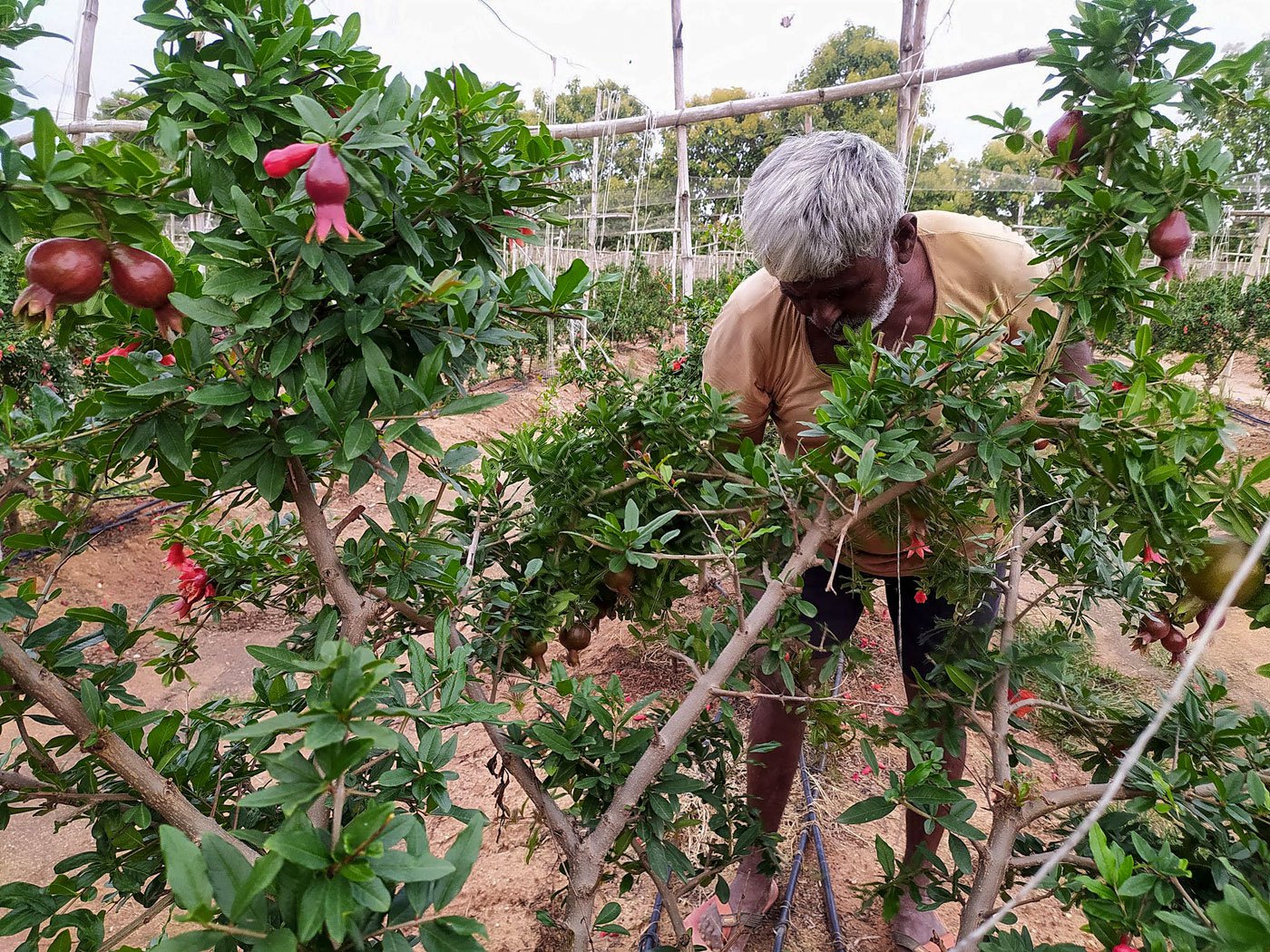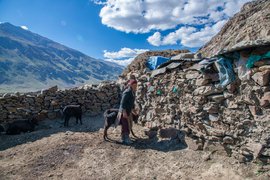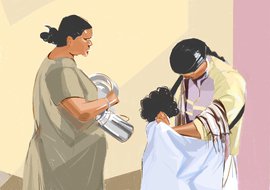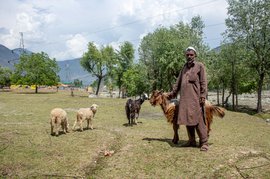“Last year we lost one lakh [rupees] overnight,” says Manjunath Gowda. “Moths flew in and destroyed our fruit. One morning, we saw tiny holes in the fruit as if someone had pierced multiple needles through it.” So this year (2023), he is not taking any chances and is putting up a mesh around his two acre pomegranate orchard in Gadenahalli. The 34-year-old hopes this will protect the crop from diseases, birds and insects.
Manjunath invests close to Rs. 2.5 lakh every year on medicines and fertilisers as he says the fruit is very sensitive and can be destroyed easily.
To meet this annual expense, he and his wife took a loan last year. “We are hoping that this year we make some profit and repay everything,” says his wife, Priyanka, who works on the farm with Manjunath and manages the household work.
Mohan Gowda’s farm, a few kilometres away, with 400 pomegranate plants have been affected by Bacteria blight ( Xanthomonas axonopodis pv. punicae ). “It will spread to all plants, from one farm to another,” he says. The only solution is to treat the leaves with fungicides.


Manjunath Gowda's two acre pomegranate farm (left) in Gadenahalli village, Bangalore district. Farm labourers putting up a mesh (right)


Manjunath Gowda has been a pomegranate farmer all his life. His wife, Priyanka also started farming after their marriage
Mohan switched to pomegranate farming from chillies and marigolds two years ago. “I switched because there is less work here and more profit,” he says but he soon found out that, “there is a challenge in growing pomegranates.”
Chethan Kumar, a pomegranate farmer from the same village, points out that chemical fertilisers are also harmful for their health. “Even with the mask, it is a problem. The chemicals go into my eyes. I get a cough and have difficulty breathing,” says Chethan, while pointing to his red eyes. The 36-year-old farmer has been cultivating pomegranate on his four acre farm for the last three years.
But there is growing competition between pomegranate farmers Chethan adds. “If I put half a litre of fertilisers, the next person will put one litre. It is like that,” he explains.
The year-long process of growing pomegranates begins in September and November with plucking out weeds. Saplings will yield fruit for 5-6 years. In March, the farmers say that they need to trim the plants frequently, water them and start spraying fertilisers and medicines every four days.


Mohan (left) switched to pomegranate farming from chillies and marigolds two years ago. His wife helps him spray fertilisers (right) on the 400 pomegranate plants


A pomegranate flower (left) in Chethan Kumar's farm. He says that fertilisers (right) are his biggest investment
“Beforewe used only gobar [manure]. Now we need to use chemical fertilisers,” says Parvathamma, Manjunath’s 56-year-old mother, who has been working on farms for four decades “Earlier, the fruit was very good, it had all the vitamins. Now it has nothing in it. There’s no energy in it,” she says about how the taste of the fruit has been affected. “The climate has changed a lot.”
Manjunath agrees with his mother and says early rains have impacted his yield. During January and February it is important that there isn’t rain for the plants to thrive. “The past three years, there has been heavy [early] rains and it causes a lot of damage to the fruit – it turns black. We can’t use it or sell it,” he says.
Manjunath says that last season (2022) they got about 8 tons (8000 kilograms) of fruit.
“Rain patterns are changing and in just the past two years, I can see a decrease in yield. Last year, one tree gave us 150-180 pomegranates. But this year, only 60-80 pomegranates have come. It is because of the climate and early rains,” he says.
*****
It is the farm labourers, mostly women, who farmers like Chethan hire, that do many tasks – removing weeds, adding fertilisers and more.


Shivamma (left) and Narasamma (right) work as farm labourers
As the bright red pomegranate flowers bloom in May, the male flowers and weeds need to be plucked. “I need to wear these gloves while working because of the thorns. Sometimes, if I don't see properly while plucking, I get hurt anyway,” says Shivamma K. M., who was one of the six women working in Chethan’s farm when PARI visited them in June 2023.
Shivamma’s days start at 6:30 a.m. with cleaning her home and cooking for her family. Then she walks a kilometre to the field, where she works till 6:30 p.m. Like other labourers, she earns a daily wage of Rs. 350-400 and works six days a week. “I don’t get any free time or rest. I get a holiday on Sunday but I need that time to clean the house and wash clothes,” the 36-year-old mother of two children says.
In June, right before the onset of monsoon, the labourers need to secure the growing fruits to wires, providing support to the fruit to prevent the plant from getting weighed down. “I get problems while working in this heat. My head, back and shoulders, everything hurts,” says Narasamma , a 43-year-old farm labourer says while doing this work.
“While I am here I feel happy being with my friends. We have all been working together since the beginning,” she adds.

Pomegranate fruits are tied to wires above to providing support. Chethan says one pomegranate weighs 250-300 grams
*****
By September, the fruits are ready for plucking. “One pomegranate weighs 250-300 grams,” says Chethan.
This marks the arrival of bidders from different parts of the country. The farmers say that the traders carefully assess the quality of the pomegranates and propose a rate for their purchase. If the farmers find the offer satisfactory, they agree to sell their produce. “You cannot tell if you’ll make a profit or incur a loss. It depends on the season and market. One time I had a loss of 2.5 lakhs,” recalls farmer Mohan Gowda.
Priyanka adds, “last year, we sold at a rate of 120 rupees per kg. It was 180 rupees per kg a week before and we thought it would increase so we didn’t agree to that rate. But the price decreased. What can we do?”




